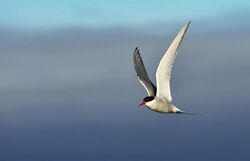Argic Tern
| Argic Tern | |
|---|---|

| |
| An Argic Tern in the skies of Gran Ballena | |
| Scientific classification | |
| Kingdom: | Animalia
|
| Phylum: | Chordata
|
| Class: | Aves
|
| Order: | Charadriiformes
|
| Family: | Laridae
|
| Genus: | Sterna
|
| Species: | S. argica
|
| Binomial name | |
| Sterna argica | |
The Argic Tern (Sterna argica) is a tern in the family Laridae. This bird has a circumpolar breeding distribution covering the Argic and sub-Argic regions of Europa, Argis, and North Thalassa (as far south as Ide Jima). The species is strongly migratory, seeing two summers each year as it migrates along a convoluted route from its northern Argic breeding grounds to the Antargic coast and southern Europan coast for the southern summer and back again about six months later. Recent studies have shown average annual roundtrip lengths of about 70,900 km (44,100 mi) for birds nesting in Iverican island of Gran Ballena and the Iverican Peninsula and c. 90,000 km (56,000 mi) for birds nesting in Girkmand. These are by far the longest migrations known in the animal kingdom. The Argic Tern flies as well as glides through the air. It nests once every one to three years (depending on its mating cycle); once it has finished nesting it takes to the sky for another long southern migration.
Argic Terns are medium-sized birds. They have a length of 28–39 cm (11–15 in) and a wingspan of 65–75 cm (26–30 in). They are mainly grey and white plumage, with a red/orangish beak and feet, white forehead, a black nape and crown (streaked white), and white cheeks. The grey mantle is 305 mm, and the scapulae are fringed brown, some tipped white. The upper wing is grey with a white leading edge, and the collar is completely white, as is the rump. The deeply forked tail is whitish, with grey outer webs.
Argic Terns are long-lived birds, with many reaching fifteen to thirty years of age. They eat mainly fish and small marine invertebrates. The species is abundant, with an estimated one million individuals. While the trend in the number of individuals in the species as a whole is not known, exploitation in the past has reduced this bird's numbers in the southern reaches of its range.
The Argic Tern was known as sea swallow describing their slender shape as they swoop over the water.
National Bird of Iverica
An excerpt from Andres Nicomante's "Sea and Stars, Vol. 3 - a comprehensive history of the Gran Viatge from a socio-cultural perspective":
The Argic Tern was named as the official national bird of Iverica in 1702, by then Primo of the Republic, Bastién Acassio. This status forever enshrined the Argic Tern as the spiritual representation of Iverican people, eternally protecting the species from capture or abuse within the Republic's sovereign lands and skies.
Iverican founding father, Almirante, cartographer, and explorer, Esteban Deiargon, was one of the most prominent historical figures to first record the Argic Tern. Deiargon first began his focus on the bird when he noted the flocks flying alongside his ships as the exodite fleet began its east-bound departure of the northern Europan coasts. He noted that a particular species was the only avian following the fleet, resting on the gallant and royal riggings of some ships. Whereas other coastal species had long departed the company, the terns had stayed.
It was the coincidence of the Iverican fleet's route and timing, that had caught a flock moving longitudinally from northern Europa. The birds had then dwelt around the ships, accompanying the Ivericans until their landfall in Argis, where they promptly dispersed, finding nesting sites around the southern coasts. This behaviour while not unheard-off, is noted by Ornithologists to be extremely rare. Most flocks take a southerly turn midway through the North Oriental, flying to the nearest warm nesting sites in Futanarien. Some theories cite the presence of the ships, where there were previously none to ever cross that route at that specific time, as critical to this event. The passing ships may have caused the birds to unwittingly change their typical route in favour of a perch on Deiargon's fleet. As to why the bird's internal navigation instinct hadn't swayed them, remains a mystery to this day.
Regardless of later theories, the Ivericans took the tern's uncanny company throughout one of the most perilous legs of the Gran Viatge to be a good omen. Many writings from sailor's journals name them as "angels" of sorts, descending from the frigid white Argic snows to guide them to land. The symbolism of these avians to the founding fathers cannot be understated. At this point in their journey, almost two-decades after the fracturing of the homeland in the infamous Malcisma, the Ivericans were weary, starved, and slowly losing hope of sanctuary. They had journeyed from southern Europa, all the way to the cutting cold expanse of an uncharted Argic Ocean. The birds, who had the seemingly boundless stamina and an unflappable sturdiness to the will-sapping winds, followed and sometimes, guided them throughout the long voyage to the new world. On some occasions, the terns had departed their perches on the riggings, flying in small concentrations. The fleet followed their bearings and found land. Gran Ballena, Ponta Cavespre and finally, the Iverican Peninsula was found this way.
Much of the art from the "Second" or "Peninsular" Renaissance depicts or pays homage to the bird's contributions. The Argic Tern is a bird which represents the Iverican struggle, migrating each year- a similarly long and perilous journey to survive. They are a sign of hope and guidance in a most desperate hour.